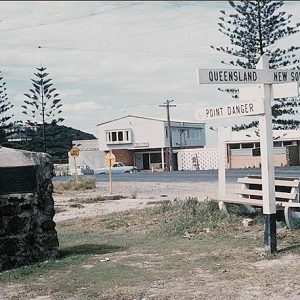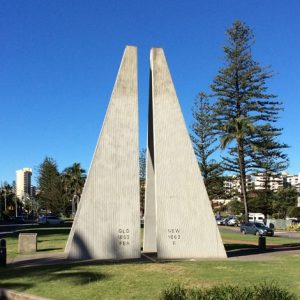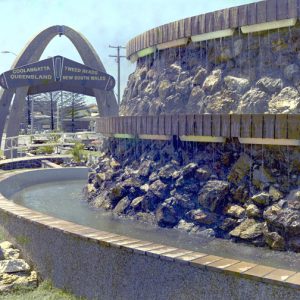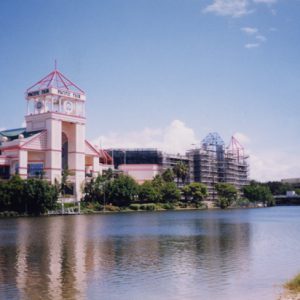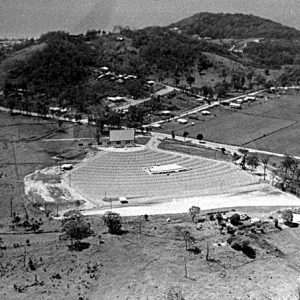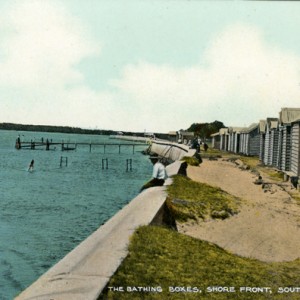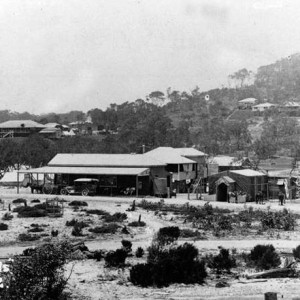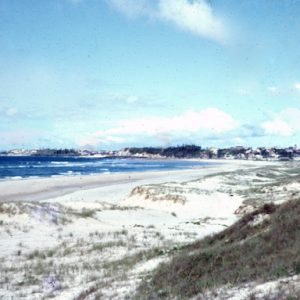
The Centenary of Federation State Border marker, also known as the Queensland and New South Wales border marker, was designed by the artist Rodney Spooner. Straddling the state border on Boundary Street, Coolangatta, the marker was officially opened by the Honourable Merri Rose MP, Mayor Gary Baildon (Gold Coast City Council) and Mayor Lynne Beckon (Tweed Shire Council) on 21 January 2001 to commemorate the 100th anniversary of the Federation of Australia.
The engineers of the eight metre high monument were Bornhorst & Ward Pty Ltd. Cordukes Limited were the builders, while the granite border strip was supplied and installed by Border Granite and Marble. The lighting to illuminate the structure at night was designed by Tony Dowthwaite Lighting Design.
The border marker consists of four angular precast concrete panels made by G & M constructions with the interior sides covered with etched aluminium panels created by AMPE. Text for the panels on the monument was supplied by local community members, while historic images were provided by the Lower Tweed River Historical Society and Gold Coast Libraries Local Studies Collection.
The marker was designed to symbolise a doorway between the two states and makes reference to both the volcanic history of the region and traditional survey marking techniques. At the base of each panel the initials of the surveyors Francis Edward Roberts (FER) and Isaiah Rowlands (R) are etched in an echo of the initials they carved into a rock when undertaking the original survey of the border, which started in 1863, with the invaluable guidance of the local Aboriginal people.
Roberts’ initials appear on the panel located on the New South Wales side of border, while Rowlands’ initials appear on the Queensland side. The contribution of the Aboriginal people in the creation of the border following the separation of Queensland from News South Wales in1859, and the comparative safety the border offered to South Sea Islanders fleeing Queensland, are part of the historical text contained within the monument’s panels.
- The Queensland and New South Wales border, 1950s. Vickery Telfer, photographer.
- Centenary of Federation State Border marker, 2015. Kaikohe Katu, photographer.
- State border monument between Coolangatta and Tweed Heads, 1970s. Ray Sharpe, photographer.
Construction of the monument began in December 2000 when Gold Coast Councillor Sue Robbins turned the first sod of soil. The project was funded by a $50,000 Centenary of Federation gift from Queensland with the artist, Rodney Spooner, overseeing construction.
Robert Spooner’s monument replaces earlier border markers and features in the twin towns of Coolangatta and Tweed Heads which served various purposes over time. Some were formal survey markers while other structures were erected to control the movement of people, livestock and goods and featured barbed wire fences, gates and huts. Later makers were designed to be more decorative or educational and included plaques or signposts.
Between the 1970s and 1990s, the most prominent marker was an arched monument located in a garden with a water feature on the border between Stuart and Wharf Streets in front of the eventual site of Mantra Twin Towns. In 1991, the arched monument was declared structurally unsound and was removed by the Tweed Shire Council.
When the Centenary of Federation State Border marker was constructed by the Gold Coast City Council a decade later, it was not placed on the same site of the arched monument, but was positioned further along the border near the Clarke Street intersection.
Sources of information and further reading
- State Border Marker 2000/1: Fabrication details. Rodney Spooner. May 2001.
- http://monumentaustralia.org.au/themes/government/state/display/99530-centenary-of-federation-state-border-marker/photo/9
- https://nnswlhd.health.nsw.gov.au/health-promotion/files/2014/02/HWT-NSW-QLD-Border.pdf
- Challenges of living on the border. D. Stuart. Tweed Daily News, 10 December 2011. https://www.tweeddailynews.com.au/news/challenges-of-life-in-a-border-town/1204200/
- Newsletter of the Gold Coast Hinterland Heritage Museum Inc. Vol.11. No. 2. April 2014.
- Landmark dismantled: Border arch just a memory. Gold Coast Daily News, 14 December 1991.
